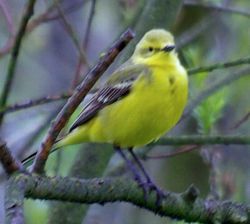Yellow Wagtail Montacilla flava
The male is an enticing yellow and green bird. The female being considerably duller, with little yellow and more brown in her plumage. Both have the typical wagtail gait of a brisk walk or short run with a backwards and forwards motion of the head and with the tail moving constantly up and down. Often it is located by its 'tsweep' call as it zips overhead with its undulating flight. The Yellow Wagtail breeds in an arc from Britain through to Siberia with a toehold in Alaska, and winters in Africa and south Asia. There are many sub-species of Yellow Wagtail, but the sub-species Montacilla flava flavissima is the Nottinghamshire Yellow Wagtail, which winters in West Africa.
Another name for the Yellow Wagtail was Ray's Wagtail, presumably named after John Ray, the famous 17th century naturalist.
Described by Sterland {Birds of Sherwood Forest -1869} in the mid-19th century as "certainly not rare", by Sterland and Whitaker {Descriptive List of the Birds of Nottinghamshire - 1879} as "a regular summer visitor", and by Dobbs {Birds of Nottinghamshire -1973} as a "common summer visitor", the Yellow Wagtail is on a bit of a downer as regards population in Nottinghamshire today. In fact the numbers of Yellow Wagtails in Britain have decreased by at least 60% {various BTO surveys} in the last thirty years and Nottinghamshire has not been immune from this. Its is on the amber list of birds of conservation concern.

The most likely reasons are due to loss of habitat for breeding and feeding. Mortality on the wintering grounds in the Sahel, south of the Sahara is not considered to be relevent, although not a lot is known of these winter habitats. Yellow Wagtails need to have two breeding attempts each year if they are raise sufficient young to halt the decline.
There are different opinions on the reasons for the national decline of Yellow Wagtails. Being ground nesters, the vegetative ground cover is important. In some recent research by Dr James Gilroy of the University of East Anglia, found in his research area, that the first nesting attempt in May was in autumn sown cereal crops, but when the time came for the second brood in late June and July, the cereals had grown too high, so they switched to other crops, especially potatoes.
Other researchers have mentioned the preference of Yellow Wagtails for short grass and bare earth for feeding and longer grasses and tussocks for breeding.
Actual numbers for the decline in Nottinghamshire is hard to come by, although published figures by the BTO's Bird Study Vol 51 say that the East Midlands has lost 80% of the breeding population on lowland wet grassland in the 20 years to 2005. Personal experience has seen the extinction as a breeding bird in the 1980s in the Beeston area, where they bred in fields by the River Trent and fed (at least part of the time) in the local sewage works. They have also ceased to breed at Attenborough Nature Reserve, (although habitat changes can account for this), but they still breed across the river Trent.
Other places where they can be seen in the summer include Netherfield, Hoveringham and the Idle valley. In the autumn they can be seen on short turfed areas such as football pitches.
Any criticisms, corrections or comments to the author Derek Huskisson

This work is licensed under a Creative Commons Attribution-Noncommercial-Share Alike 2.0 UK: England & Wales License.
